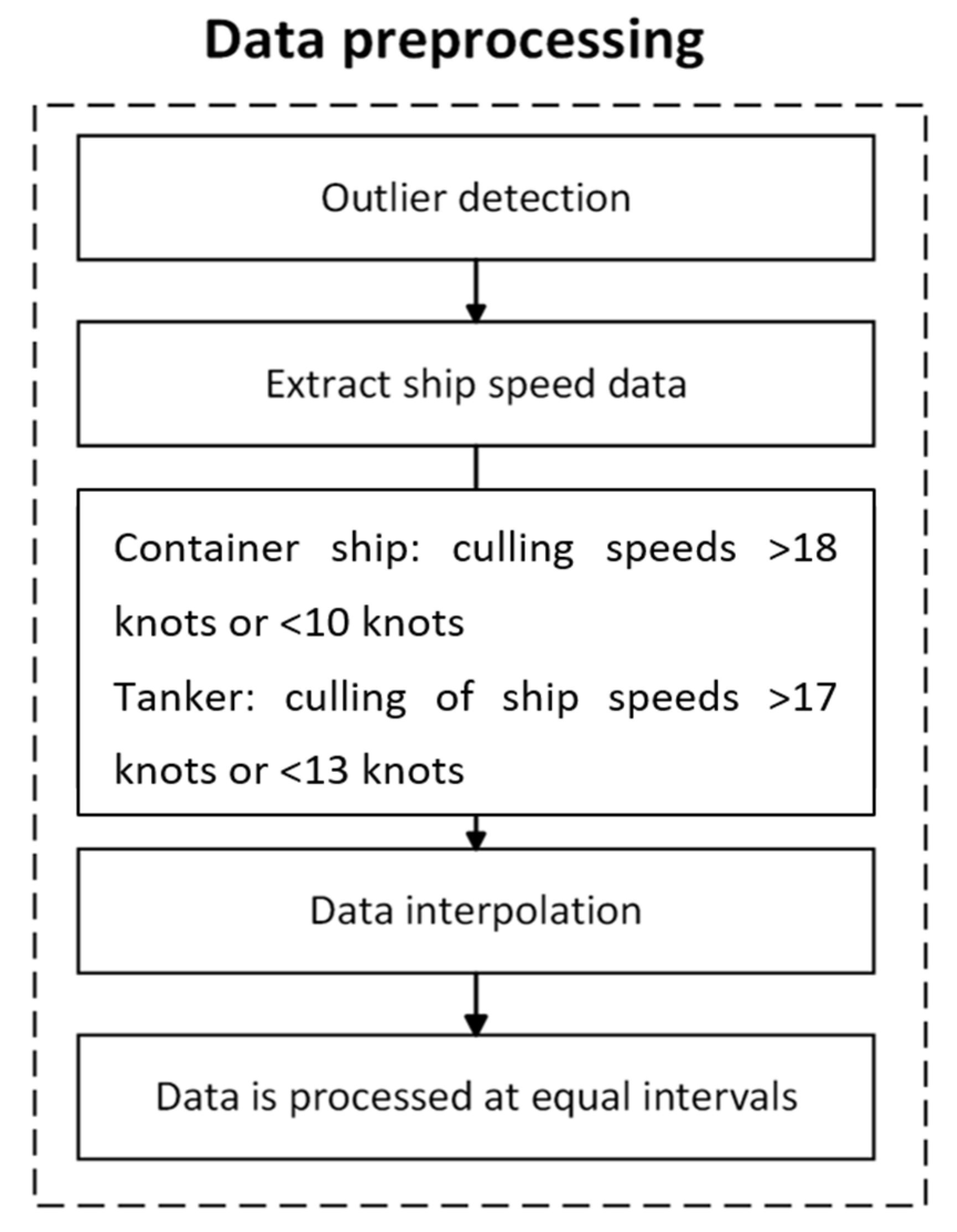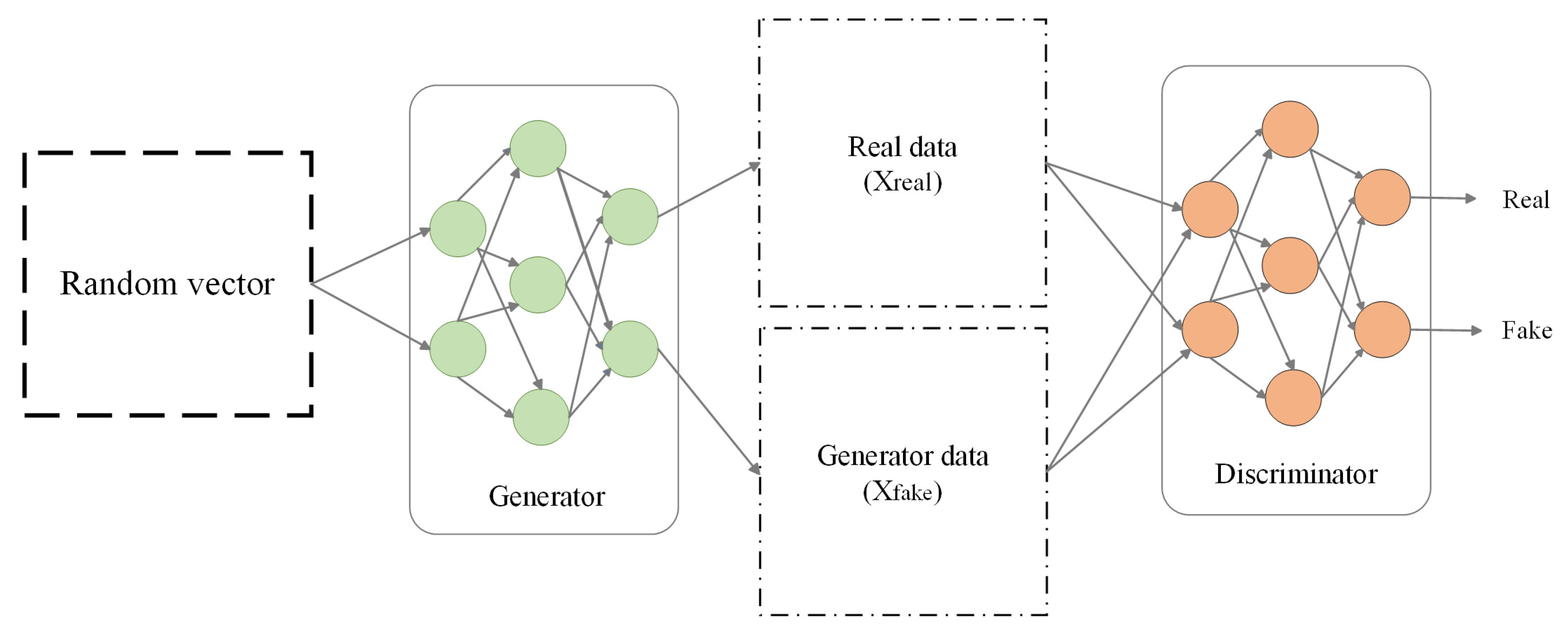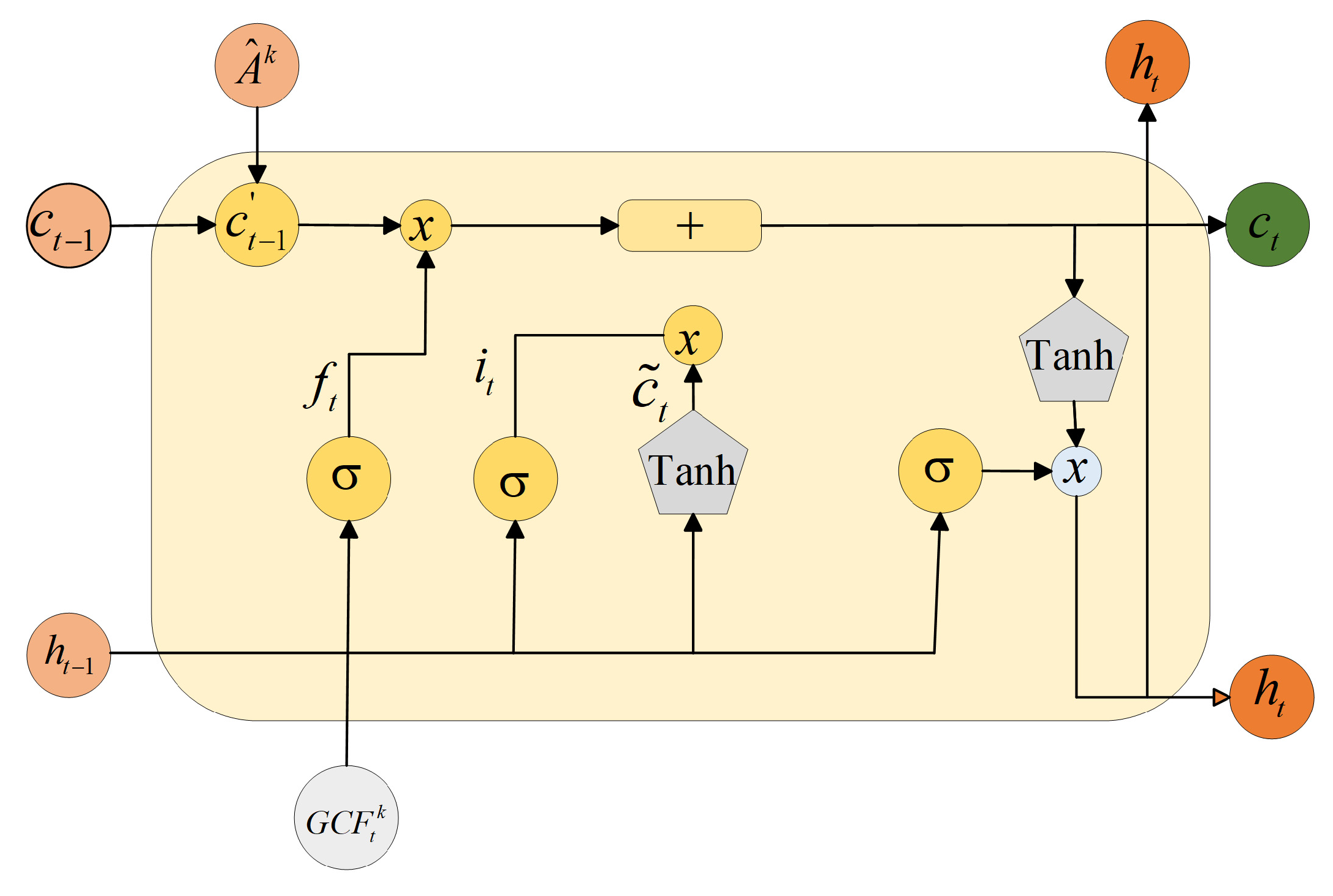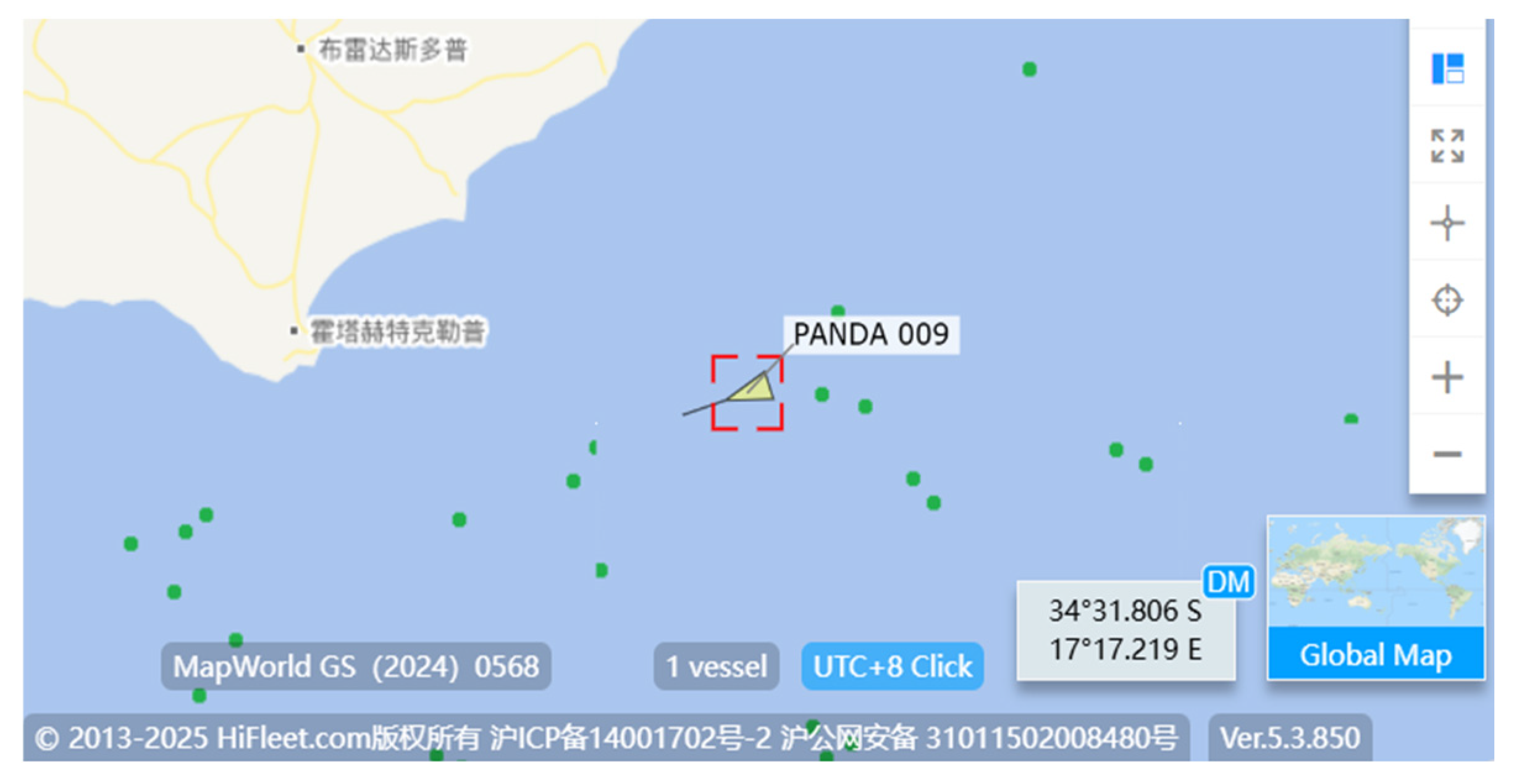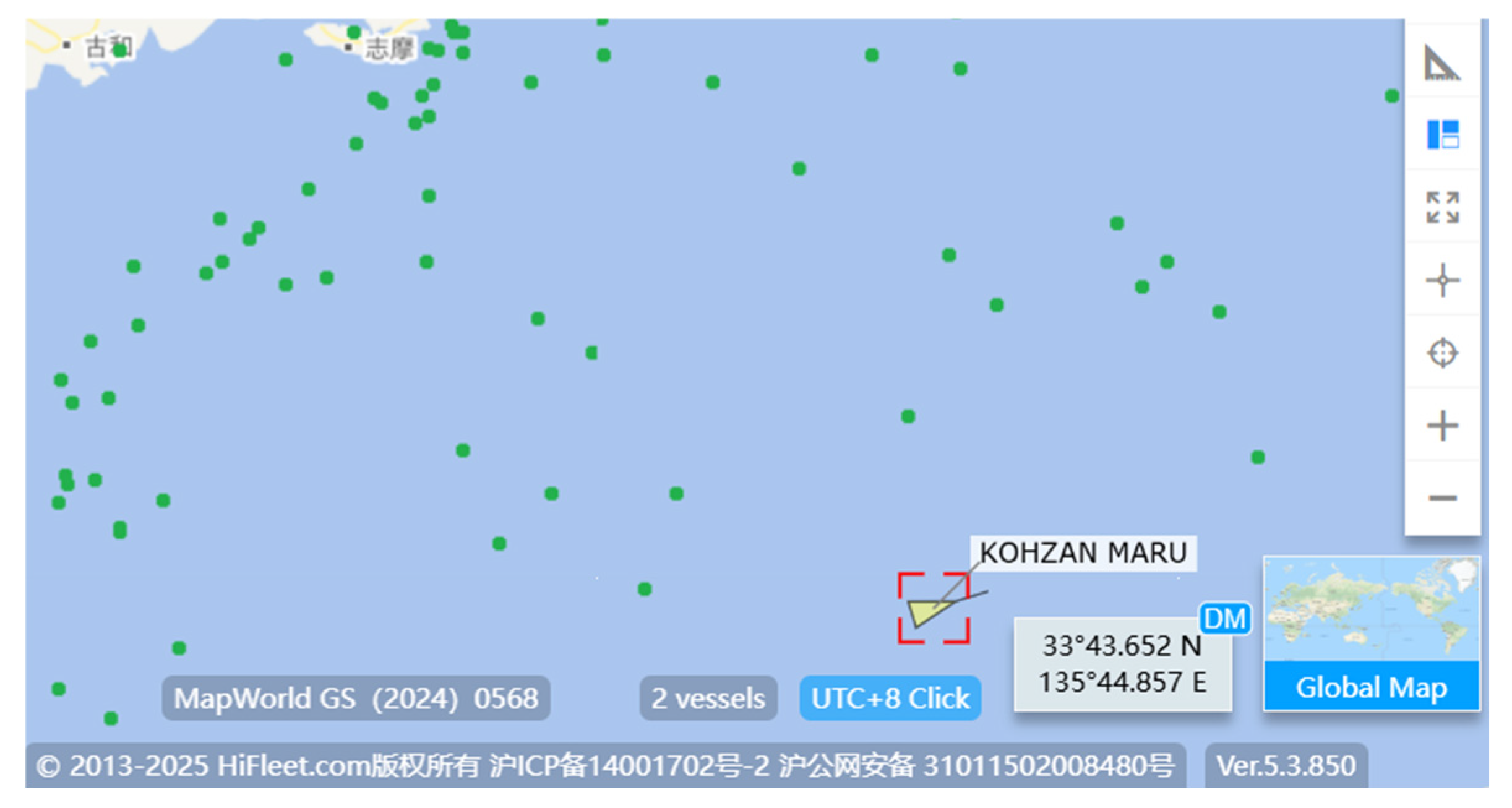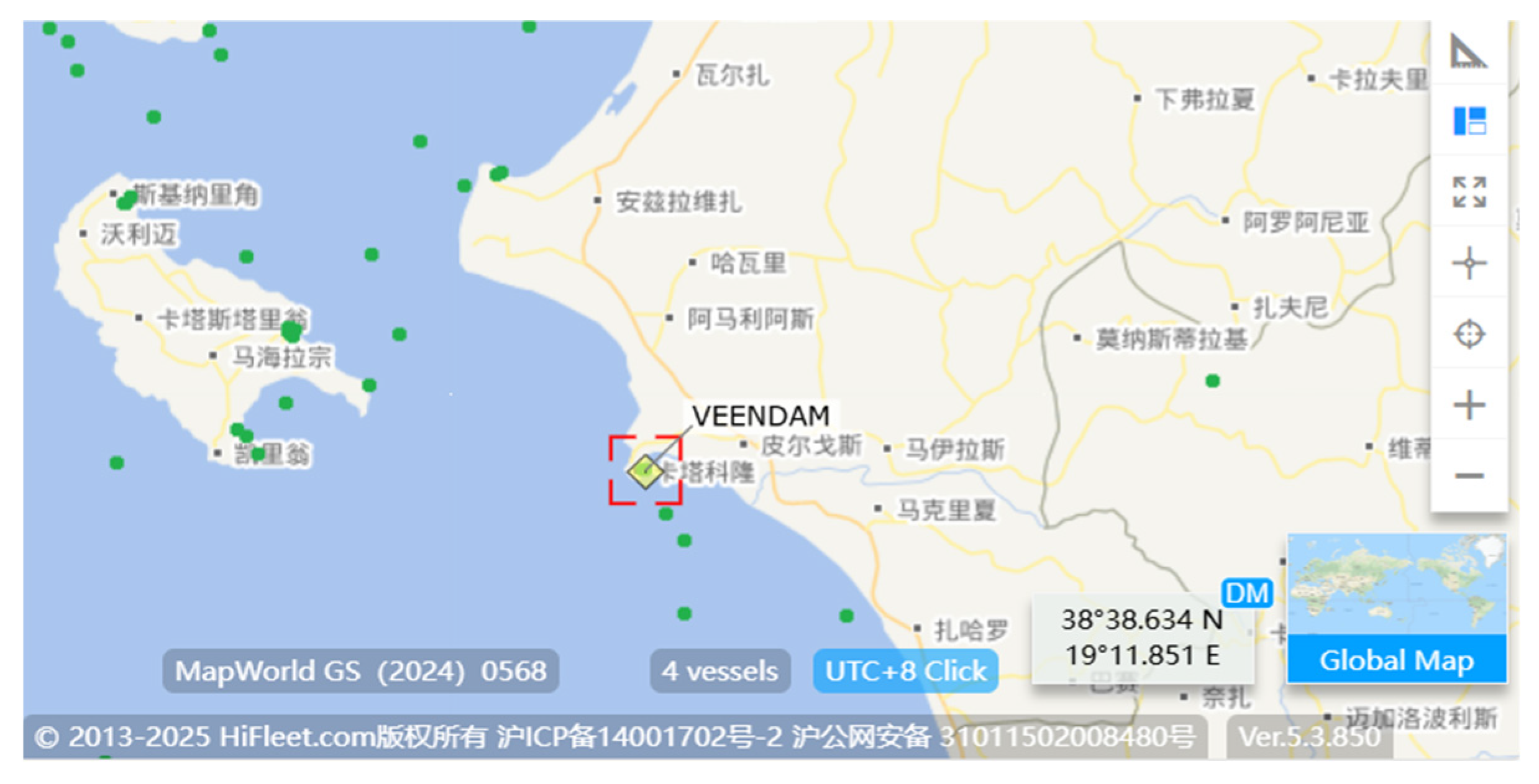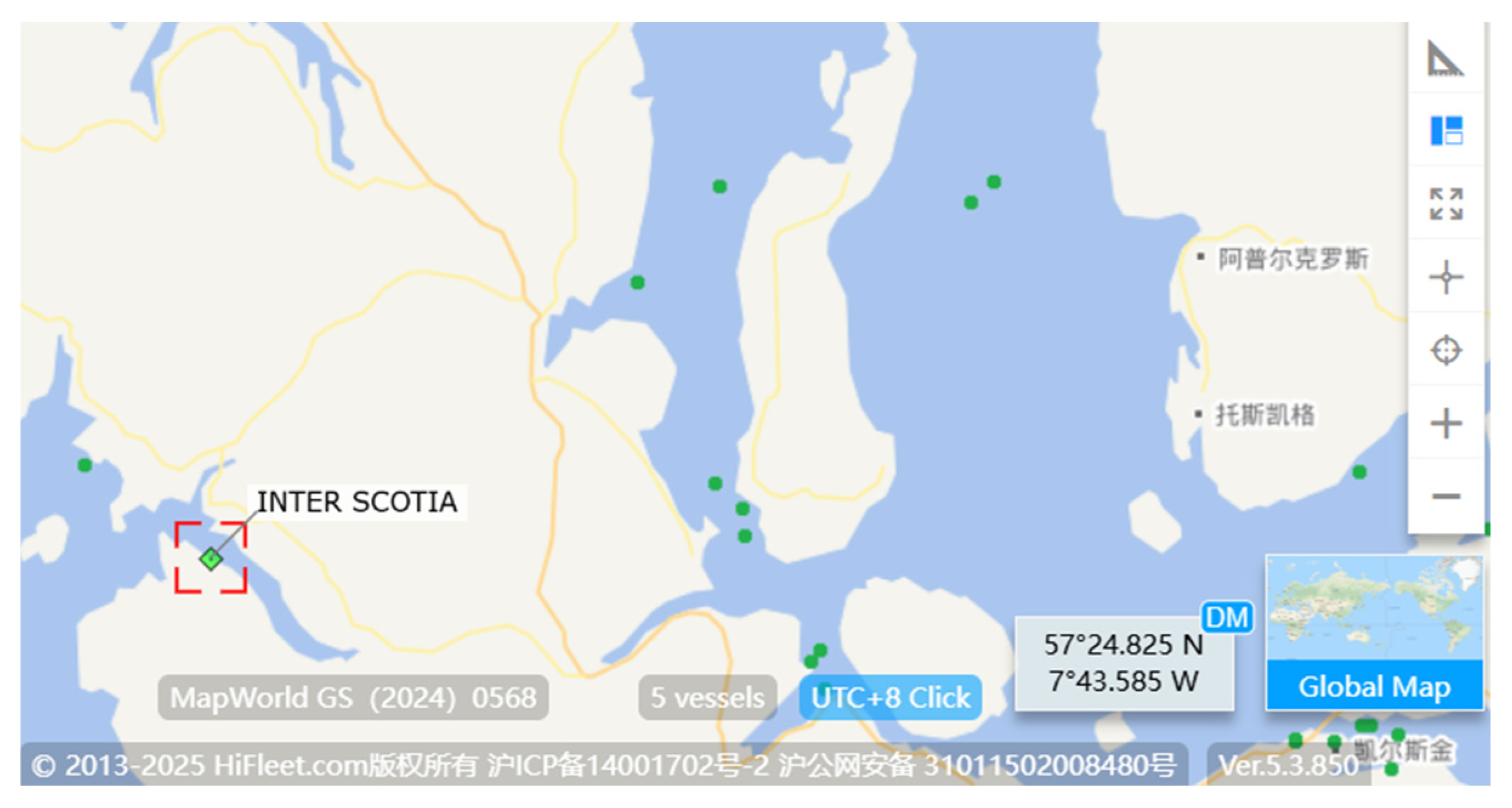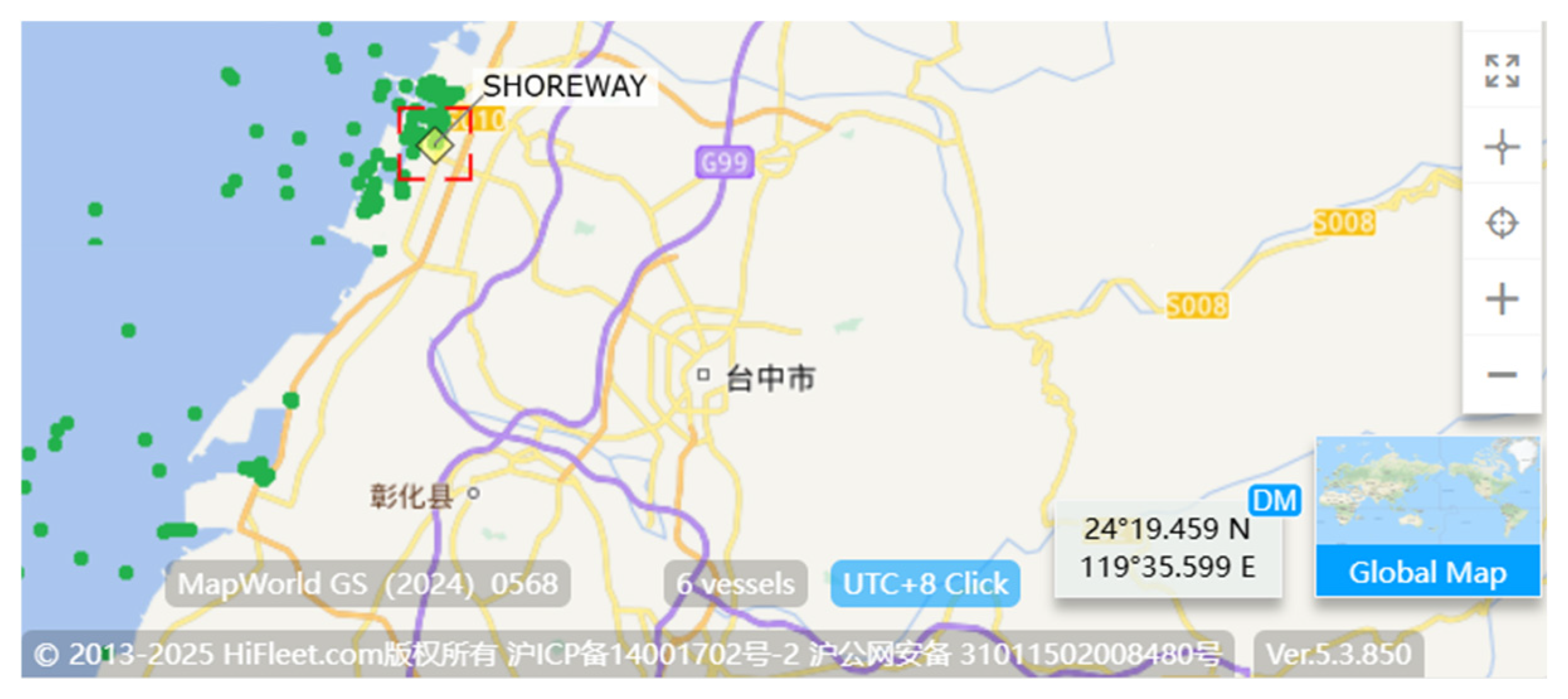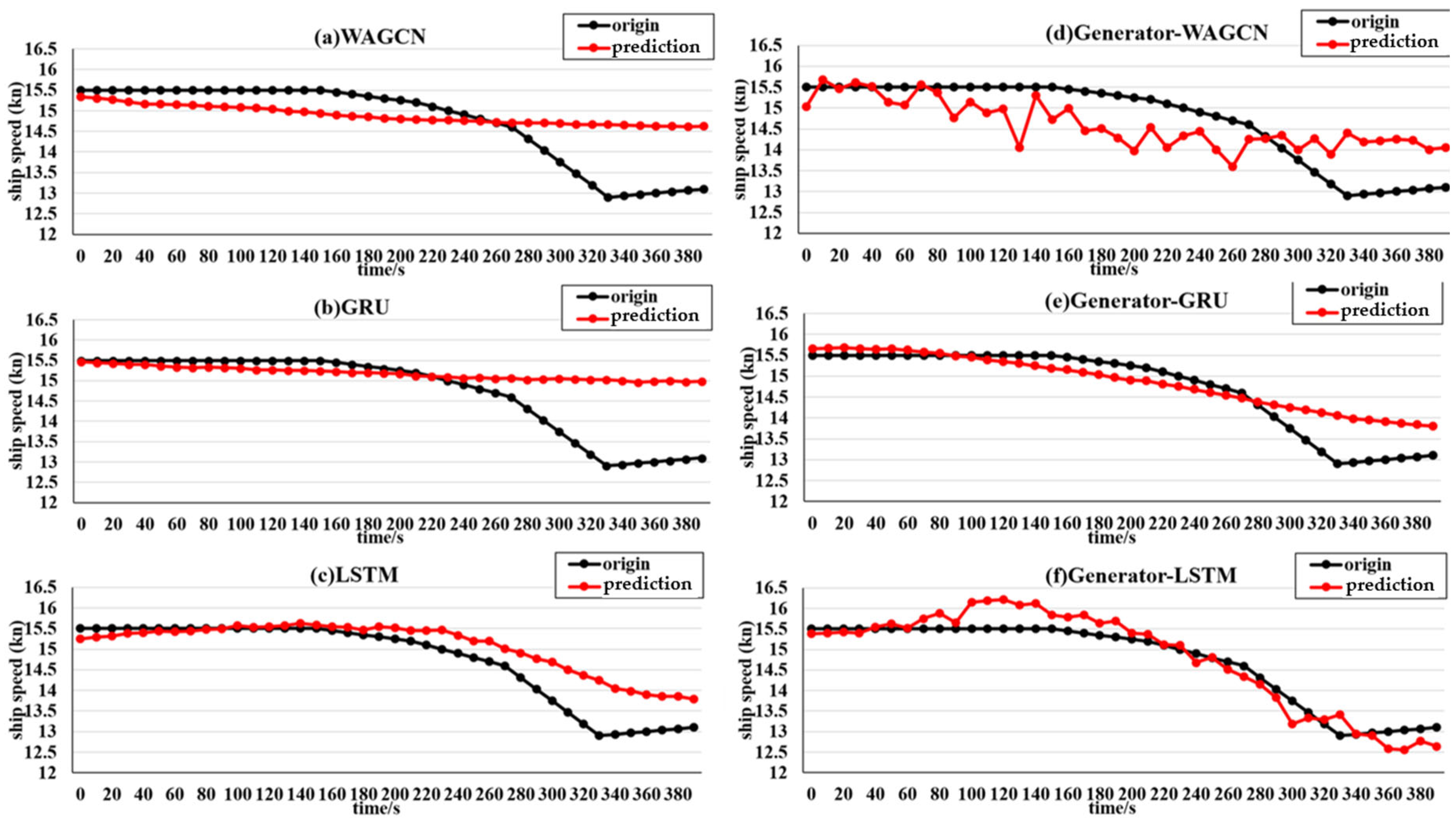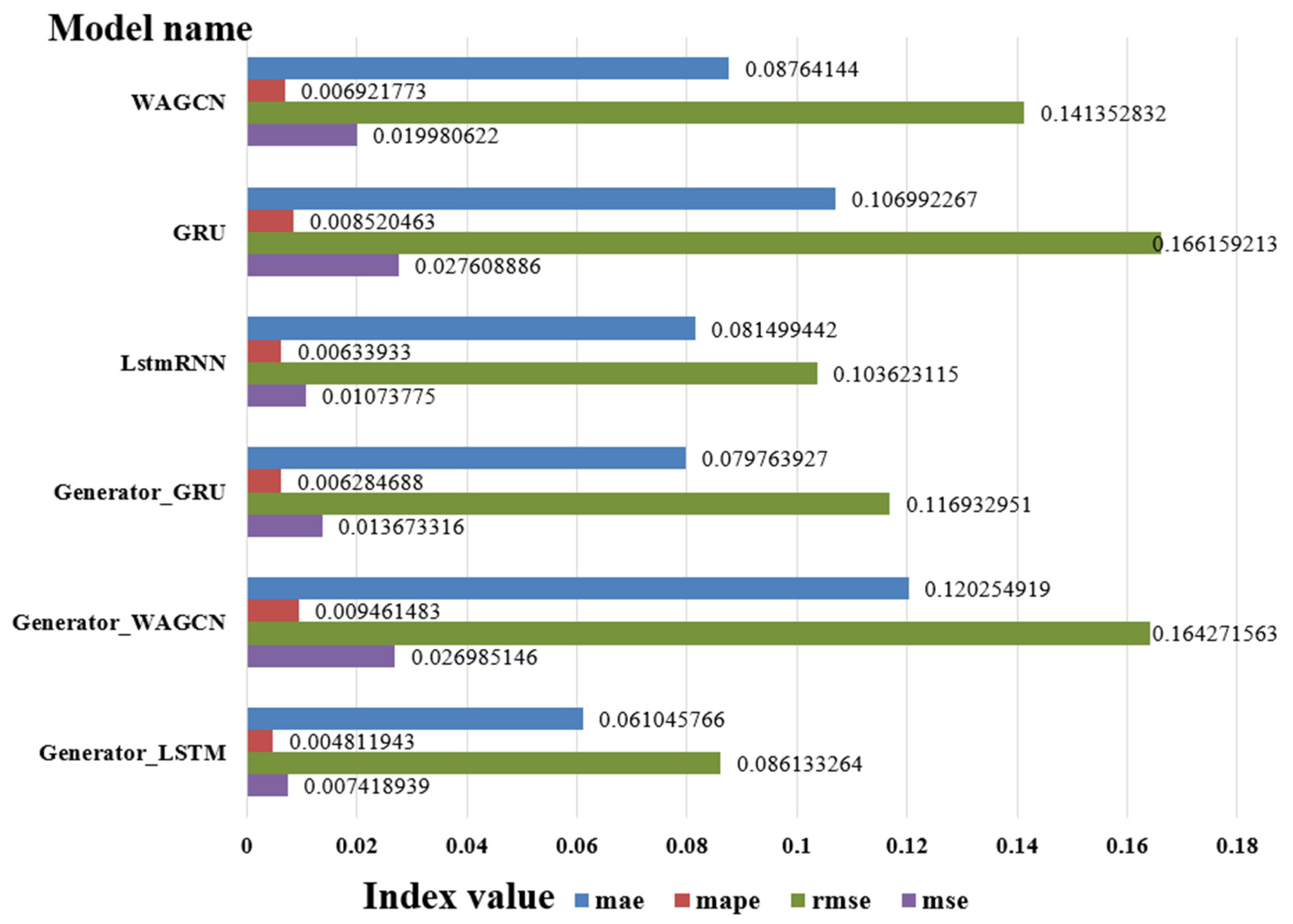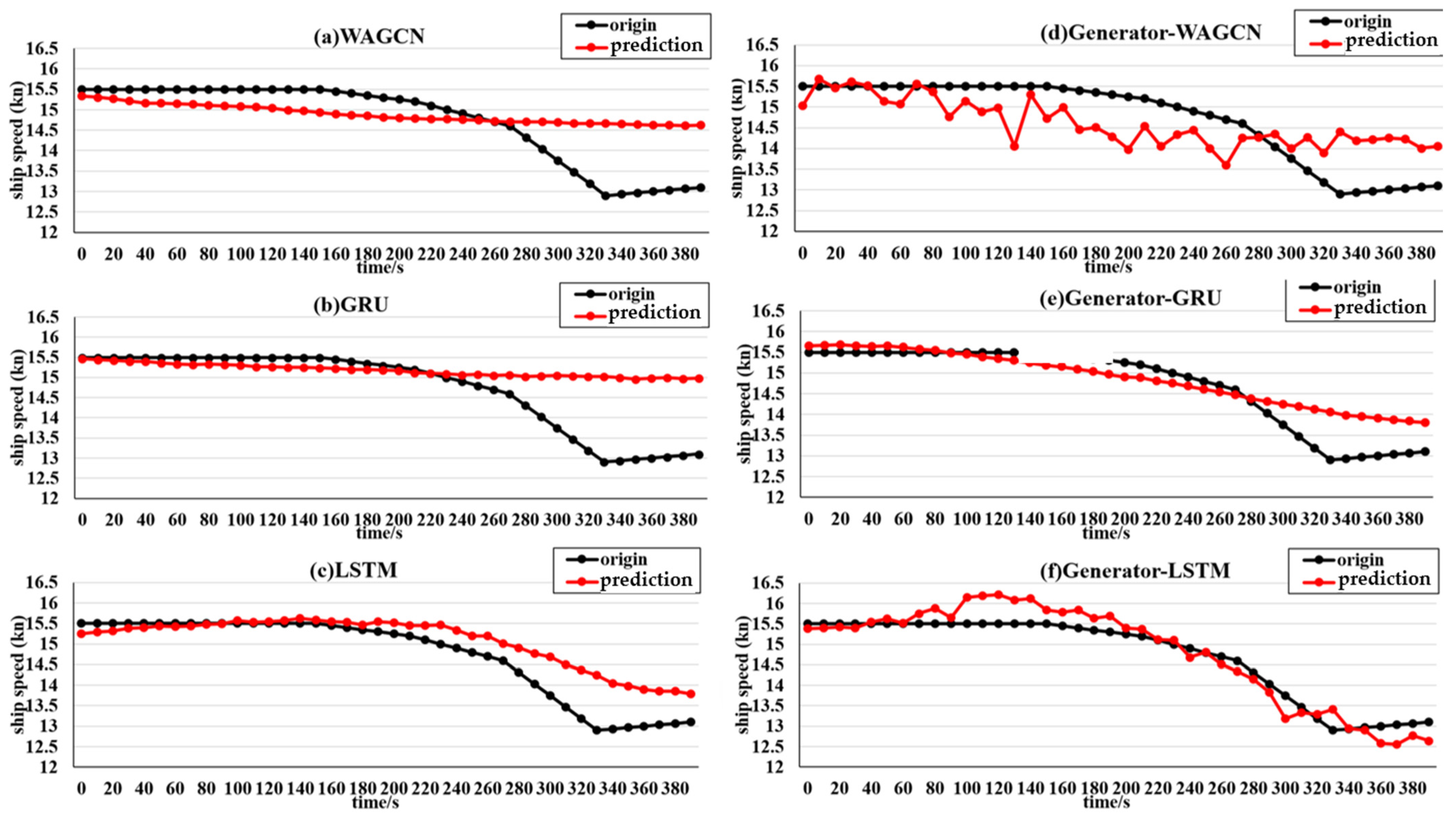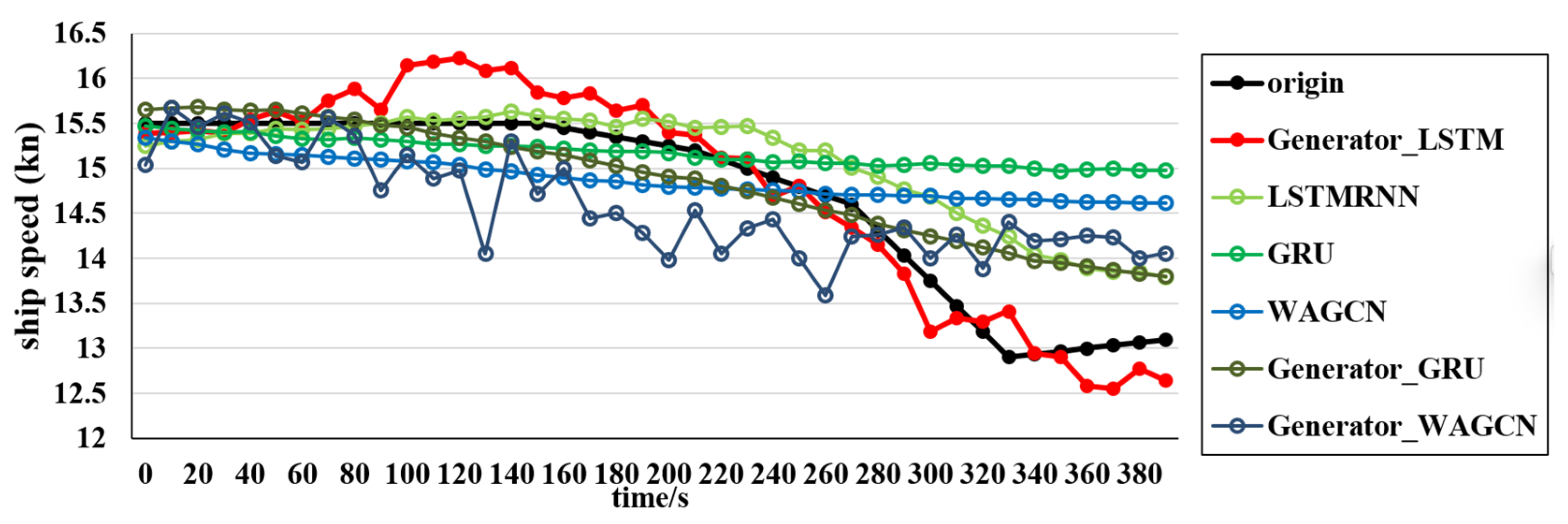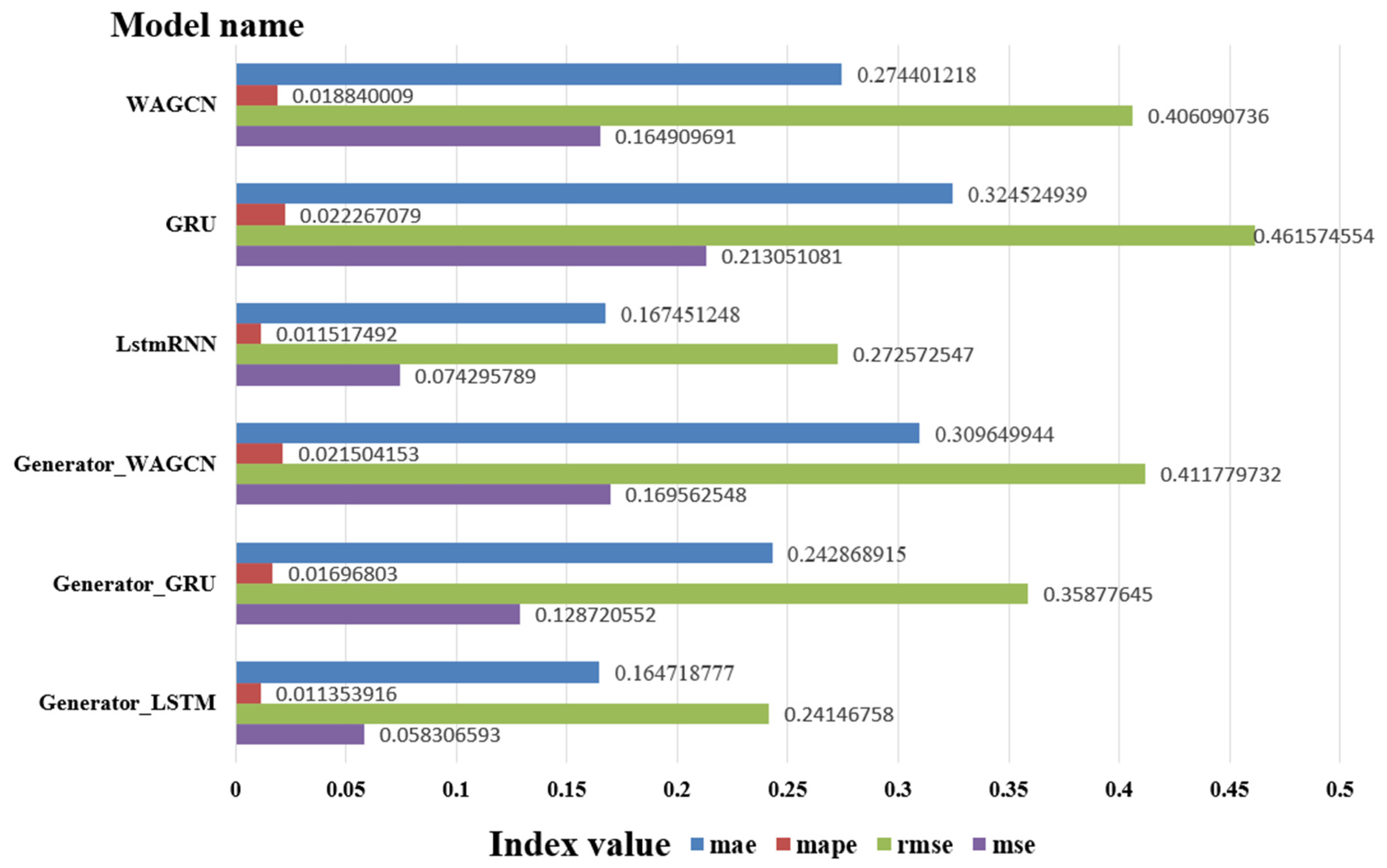The experimental scenarios selected six types of ships, namely, container ships, oil tankers, bulk carriers, passenger ships, fishing boats, and dredgers; these can represent the ship scenarios within a certain range. The experimental comparison models include the LSTM, GRU, WAGCN, GAN–GRU, and GAN–WAGCN. Meanwhile, the benchmark tests of the target model GAN–LSTM on Transformer and GNN are included, and have certain substantive significance for the experimental verification. The comparison of the experimental index results for the six types of ships shows that GAN–LSTM has the best effectiveness in predicting ship speed. However, for the purpose of a more in-depth and critical discussion of the experimental results, it encompasses three aspects: limitations, error analysis, and practical significance. The following is a detailed elaboration of these dimensions.
4.1.1. Limitations
- (1)
Discussion relating to the limitations of GAN–LSTM in predicting ship speed
In terms of data quality and quantity, the performance of the GAN–LSTM model usually depends on the quality and diversity of the training data. If the data contain noise, or are incomplete or biased, the generated prediction results may not be accurate. In the application of ship-speed prediction, collecting complete and accurate historical data is a challenge, especially due to the influence of factors such as having different types of ships, different routes, and weather conditions. A GAN–LSTM usually requires a large amount of historical data to train the model. For certain specific areas or special types of ships, it may be difficult to collect sufficient training data, which limits the performance of the model.
In terms of the complexity of model training, a GAN–LSTM requires the training of both the generator and the discriminator simultaneously, and the LSTM part also needs to handle long-term series data. This may lead to the model training process becoming extremely complex, requiring a large amount of computing resources and time for convergence. The generator in a GAN may experience pattern collapse; that is, the generated prediction results might lack diversity, resulting in the model’s inability to accurately capture the complex changes in ship speed, especially when ships are affected by various factors such as weather and sea conditions. Both the GAN and the LSTM themselves have many hyperparameters. The selection of these parameters will affect the performance of the model, and the parameter tuning process requires a large number of experiments. If the model is overly dependent on the training data, it may lead to overfitting, that is, performing poorly on new data. Especially in the prediction of ship speed, the different navigation conditions of ships may lead to gaps between the training data and the actual scenarios, which will affect the generalization ability of the model.
In addition, the speed of a ship is not only affected by historical speed data, but also by many external environmental factors, such as wind speed, ocean currents, weather, and tides [
34]. Although a GAN–LSTM can capture certain patterns of ship speed through historical data, it is difficult for it to directly simulate these complex external factors, resulting in limitations to its prediction accuracy.
- (2)
Discussion relating to the respective limitations of the remaining experimental models compared as to ship-speed prediction
As to the limitations of an LSTM, when dealing with long-term series data, although the LSTM represents an improvement, compared to traditional RNN, with respect to extremely long series of data, it may encounter problems such as vanishing or exploding gradients, resulting in a decline in its ability to capture long-term dependencies. The computational overhead of an LSTM is relatively high, especially when dealing with complex time-series data, which may reduce the real-time performance of the model. This is a limitation for application scenarios with high real-time requirements, such as ship-speed prediction [
35].
As to the limitations of a GRU, the GRU performs slightly worse, relative to the LSTM, when modeling long-term and short-term dependencies. Although it has fewer parameters and higher computational efficiency, when capturing very long-term dependencies, the GRU performs worse, relative to the LSTM. The structure of the GRU is simpler than that of the LSTM, which also means that it is not as flexible as an LSTM when dealing with complex time-series data, especially under complex navigation conditions.
As to the limitations of a WAGCN, the WAGCN is a graph convolutional network, and is usually used to handle graph-structured data. In the context of ship-speed prediction, although it can effectively handle information with graph structures, if the task data do not have a clear graph structure, the WAGCN cannot function effectively. A WAGCN requires that the input data have a good graph-based informational structure, or that the relationships between ships needed to be modeled, which would increase the complexity of data processing and the cost of preprocessing.
As to the limitations of a GAN–GRU, similar to a GAN–LSTM, the GAN–GRU also faces the problem of generator pattern collapse, which affects the accuracy of the model. The GRU has fewer parameters compared to an LSTM, but its ability to handle long-term series is poor and it cannot effectively capture long-term dependencies in the changes of ship speed.
As to the limitations of a GAN–WAGCN, the GAN–WAGCN combines the advantages of graph convolution and Generative Adversarial Networks, but is also limited to graph-structured data. If there is no clear graph structure of the relationships between ships, it would be difficult to model, and the effectiveness of the model would be affected. A GAN–WAGCN faces a training instability problem similar to those of other GAN models and requires a good training strategy to avoid the problems of generator pattern collapse and the inability of the discriminator to be effectively trained.
- (3)
Discussion of the limitations of the benchmark tests for the GAN–LSTM, the Transformer and GNN
The discussion and analysis of the limitations of a GAN–LSTM have been elaborated specifically in “(1) Discussion on the limitations of a GAN–LSTM in predicting ship speed” in this section and will not be repeated here.
The limitations of Transformer are mainly manifested in the following four aspects:
High memory consumption occurs when processing long sequences. Although Transformer is more efficient than are the RNN and LSTM when dealing with long sequences, its self-attention mechanism requires calculating the interaction information for all input sequences, which leads to high computational and memory overhead. For particularly long time series, the problem of low computational efficiency may be faced.
Transformer has a strong dependence on data quality. The Transformer model performs very well on high-quality and large-scale data. However, if the data quality is poor or the data volume is insufficient, Transformer may not achieve the expected effect, and this may even lead to overfitting due to the instability of the training data [
36].
The lack of time-dependent modeling makes it difficult to handle the sequential nature of time series. Although the self-attention mechanism of Transformer can capture the dependencies at long distances in the sequence, it itself lacks an inherent mechanism for handling temporal order, which makes it less direct and effective than an LSTM when dealing with tasks that strictly rely on temporal order, such as ship-speed prediction.
Real-time prediction of delay proves difficult. Since Transformer needs to perform global calculations on the entire sequence when calculating self-attention, it will encounter computational bottlenecks in real-time or low-latency prediction tasks. Especially in application scenarios that require rapid response, Transformer cannot complete the prediction in a timely manner.
The limitations of GNN are mainly manifested in the following four aspects:
The construction of graph data is complex and the construction of graph structure is difficult. GNN mainly relies on graph structures to represent the relationships between data points. For ship-speed prediction, constructing an appropriate graph structure can be very complex, especially when the relationships between data are relatively implicit or difficult to model clearly.
It is difficult to capture global dependencies in the balance between local information and global information. Although GNN can model the relationships between local nodes well, it is not as direct and effective as an RNN or LSTM when dealing with long-term global dependencies. Ship-speed prediction involves rather complex global relationships in terms of time and space, and GNN performs poorly in this aspect.
The computational complexity of graph networks is high. When graph neural networks handle large-scale graphs, the computational and memory overheads will also increase rapidly, especially when the graph structure needs to be updated frequently and complex graph convolution needs to be performed, which will lead to a decrease in the efficiency of the model in the training and inference stages [
37].
It is prone to overfitting small-scale data. In the practical application of ship-speed prediction, the dataset is not particularly large. Especially in the case of missing data or a substantial amount of noise, GNN is prone to overfitting, resulting in a poor generalization ability of the model.
4.1.2. Analysis of Errors
The first source of error is in the AIS data quality issues. The AIS system itself may be affected by environmental factors such as weather, sea conditions, or terrain, resulting in errors or inaccuracies during data collection. For example, ships may lose signals, or signals may be interfered with, resulting in positional errors. Inaccurate position and velocity information will affect the training and prediction results of the GAN and LSTM models. In addition, AIS data usually have a time delay, especially when the vessel is far away or the signal coverage is poor. The AIS system sometimes loses data due to hardware or communication issues. The delay or absence of historical data can lead to the inability to obtain complete information during model training, which may result in the inability to accurately capture the changing trends in ship speed during the training process, thereby affecting the prediction accuracy.
The second source of error is in the dynamic environmental factors. The speed of a ship not only depends on the operation of the vessel itself, but is also affected by the marine environment. These external factors may not have been fully considered or might be difficult to quantify accurately. If these external factors are not fully modeled or reflected in the AIS data, the prediction results of the model may not accurately reflect the actual changes in ship speed.
The third source of error is in the complexity of time-series characteristics. The variations in ship speed may present complex nonlinear and periodic characteristics. Although an LSTM is suitable for processing time-series data, it may be difficult to fully capture all time-varying patterns associated with ship speed. If the LSTM model fails to fully capture these complex time-series patterns, this may lead to an increase in prediction errors, especially during long-term predictions, in which the errors will accumulate over time.
The first dataset bias is the time synchronization bias. AIS data typically contain the timestamps and positions of ships, but due to network delays, communication issues or equipment failures, the reporting times of ships may not be completely synchronized. Therefore, there may be a certain deviation between the timestamp and the actual ship speed. Time synchronization deviation can lead to the disruption of the temporal order of data, thereby affecting the learning effectiveness of the LSTM model for the time series.
The second dataset bias consists of data noise and outliers. AIS data may sometimes contain noise or outliers, which may be caused by factors such as sensor failure and signal interference. Data noise and outliers can make it difficult for the LSTM model to learn effective patterns from normal data, affecting the training effectiveness of the model.
The third dataset bias is in the nonlinear relationship between ship speed and position. The relationship between the speed of a ship and its position may be a complex nonlinear one, and the speed of a ship may be affected by factors such as waterways, traffic density, and wind speed. In AIS data, the relationship between ship speed and position is not a simple linear one, but has strong dynamic changes. An LSTM is capable of handling nonlinear relationships in a time series. However, if the nonlinear relationships in AIS data are not modeled correctly, the LSTM model may have difficulty accurately capturing the true laws of ship-speed changes.
4.1.3. Practical Significance
The first element of practical significance is that a GAN–LSTM can improve the prediction accuracy of ship-speed prediction in practical applications, enhance the robustness of the model, and achieve ship-speed optimization.
Traditional time-series prediction methods may have limitations when dealing with complex ship-speed data, especially when the data are affected by multiple factors such as the marine environment, climate change, and ship-types. By combining LSTM with a GAN, the time-series characteristics and potentially nonlinear relationships in the ship-speed data can be effectively captured. Meanwhile, training samples that are more diverse are generated through the GAN to enhance the generalization ability of the model, thereby improving the prediction accuracy. Combining the generation ability of a GAN and the time-series modeling ability of an LSTM can enhance the model’s adaptability to various forms of complex and nonlinear data. By generating synthetic samples, a GAN can expand the training dataset, especially in the case of scarce data, enhancing the robustness of the model, enabling the model to better cope with incomplete or variable data in practical applications. In addition, accurate prediction of ship speed not only helps to enhance the safety of shipping, but also plays a positive role in optimizing routes, saving fuel, and reducing shipping costs. Through more accurate ship-speed prediction, ship managers can better plan the voyage and avoid unnecessary speed fluctuations, and thereby improve operational efficiency.
The second element of practical significance is that the GAN–LSTM can achieve automated and real-time prediction in predicting ship speed in practical applications, improving shipping logistics and achieving the goal of energy conservation and emission reduction.
The GAN–LSTM model can achieve automated ship-speed prediction in shipping systems. With the advancement of self-driving ships, real-time prediction of ship speed is of great significance in aspects such as navigation control, collision avoidance, and channel selection. The GAN–LSTM model can be utilized to provide real-time speed adjustment suggestions for ships, helping crew members better cope with varying sea conditions. In the shipping and logistics industry, accurate prediction of ship speed not only helps ships better control their voyage time, but also enables logistics companies to schedule ships more efficiently, optimizing the cargo transportation process, reducing delays, and thereby enhancing overall logistics efficiency and customer satisfaction. Accurate ship-speed prediction can help shipping companies adjust the speed of a ship based on its real-time conditions, thereby optimizing fuel consumption and reducing carbon emissions. This is of positive significance for achieving the green transformation and energy conservation and emission reduction goals of the shipping industry.
Finally, deploying the ship-speed prediction model based on a GAN–LSTM in the actual maritime traffic management system has significant practical significance.
Firstly, it can enhance navigation safety, optimize the voyage range, and reduce navigation delays, thereby improving traffic flow management and strengthening the real-time response capability of the system. Accurate prediction of ship speed helps ensure that ships can navigate as planned and reduces potential safety hazards caused by excessive fluctuations in ship speed. By using the GAN–LSTM model, the real-time speed of ships can be accurately predicted, helping the maritime traffic management system to monitor and adjust the navigation routes in real time, avoiding accidents such as collisions and stranding, and ensuring navigation safety. Traditional voyage planning usually relies on historical data and preset speeds, while the GAN–LSTM model can conduct dynamic prediction in combination with real-time data. This means that shipping companies and maritime traffic management institutions can adjust routes and speeds in real time based on accurate ship-speed predictions and optimize voyages, thereby reducing delays, improving the operational efficiency of vessels, and enhancing the overall logistics operation speed. A GAN–LSTM combines the advantages of Generative Adversarial Networks and Long Short-Term Memory networks and can quickly adapt to the changes in ship-speed prediction in the unpredictable marine environment.
Secondly, it can enhance fuel efficiency and reduce emissions, improve the efficiency of resource allocation, and provide significant support for automated navigation and intelligent shipping. In maritime traffic management, the reasonable prediction of ship speed can help ships better control their speed and avoid sailing too fast or too slow. A reasonable speed can not only save fuel but also reduce carbon emissions, which is in line with the green and environmental protection goals increasingly emphasized by the modern shipping industry. With the gradual application of automation technology, the role of accurate ship-speed prediction in automated navigation is particularly crucial [
38]. The ship-speed prediction based on the GAN–LSTM model can provide accurate real-time data for the automated navigation system, helping ships automatically adjust the speed and route without manual intervention to ensure the safety and efficiency of navigation.
